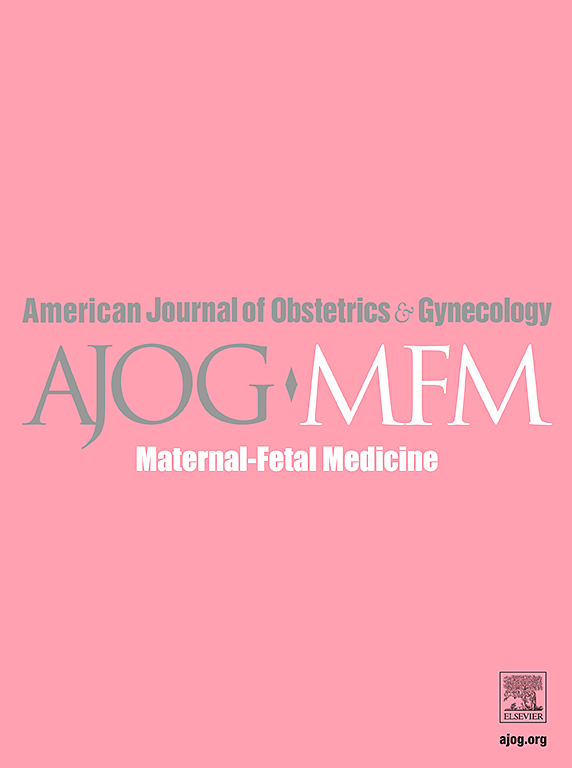Effect of a perineal protection device in vacuum-assisted births—a prospective randomized controlled interventional trial
IF 3.8
2区 医学
Q1 OBSTETRICS & GYNECOLOGY
American Journal of Obstetrics & Gynecology Mfm
Pub Date : 2024-10-19
DOI:10.1016/j.ajogmf.2024.101532
引用次数: 0
Abstract
BACKGROUND
Birth tears are common after vaginal birth with a prevalence of up to 85%, especially in vaginal-assisted births. Because birth trauma can cause physical and psychological short-term and long-term maternal morbidity, it is essential to improve maternal outcomes at birth.
OBJECTIVE
This study aimed to evaluate the effect of a perineal protection device on the rate of spontaneous birth tears in the posterior compartment in vacuum-assisted births and the feasibility and safety of the device.
STUDY DESIGN
In a prospective, randomized controlled interventional trial from July 2020 to October 2022, we evaluated the application of a perineal protection device in vacuum-assisted vaginal births in a tertiary care center. A total of 1998 patients were asked to participate, and 1574 patients with singletons at ≥36 weeks of gestation gave their informed consent before birth. Ultimately, 209 were included according to a power calculation, performed in advance, with a statistical power of 80% and a significance level of 5% for an expected reduction in the rate of the primary composite outcome of 20%. The primary composite outcome was the rate of low-grade perineal and/or vaginal tears in the posterior compartment. Secondary outcomes were the rate of high-grade perineal tears and episiotomies, the feasibility of the device, and its safety for the mother and child. Descriptive statistics and a logistic regression analysis were performed in an intention-to-treat, a per-protocol, and an as-treated analysis, using SPSS, version 29.0.0.0, and R. A P value of <.05 was considered statistically significant.
RESULTS
Of the 1574 patients, 249 (15.8%) had an indication for vacuum-assisted vaginal birth, and 217 (13.8%) of those were randomized. An addition 8 patients (0.5%) were excluded because the birth ended without vacuum assistance. Of the remaining 209 patients, 105 formed the intervention group (application of the device), whereas 104 formed the control group (without application of the device). No differences in primary and secondary outcomes were found in the intention-to-treat and per-protocol analysis. In the intention-to-treat analysis, 79 patients (75.2%) in the intervention group and 73 patients (70.2%) in the control group (P=.4) met the primary endpoint. In the per-protocol analysis, the primary composite outcome was seen 53 patients (77.9%) in the intervention group and in 73 patients (70.2%) in the control group (P=.27). For the as-treated analysis, 68 of the 105 patients (65%) remained in the intervention group after exclusion of 37 (35%) patients with failed application of the device. Consequently, 141 formed the control group. In the as-treated analysis, there was also no difference in the primary composite outcome between the 2 groups (53 patients [77.9%] in the intervention group and 99 patients [70.2%] in the control group). However, within the secondary outcomes, we found a significantly lower rate of mediolateral episiotomies in the intervention group (29% vs 45%; P=.034). No adverse outcomes for the mother and child were seen. In one-third of cases, the device was difficult to place correctly and/or to keep correctly in place.
CONCLUSION
The perineal protection device was not able to reduce the primary composite outcome of the study among women who gave birth by vacuum assistance. Although this was not the primary end point, a lower rate of mediolateral episiotomies was observed when the device was used correctly. As a limitation, difficulties with the application of the device occurred in 33% of cases. Nevertheless, no adverse events in association with the device were observed for either mother or child in our cohort.
会阴保护装置对真空助产的影响--前瞻性随机对照干预试验。
背景:分娩裂伤是阴道分娩后的常见现象,发生率高达 85%,尤其是在阴道助产中。由于分娩创伤可导致产妇短期和长期的生理和心理疾病,因此改善产妇的分娩结局至关重要:目的:评估会阴保护装置对真空助产中后区自发性产道撕裂率的影响,以及该装置的可行性和安全性:研究设计:2020 年 7 月至 2022 年 10 月,我们在一家三级医疗中心开展了一项前瞻性随机对照干预试验,评估了会阴保护装置在真空辅助阴道分娩中的应用。1998名患者被要求参与,1574名妊娠≥36周的单胎患者在分娩前签署了知情同意书。最终,根据事先进行的功率计算(统计功率为 80%,显著性水平为 5%),有 209 名患者被纳入其中,期望将主要综合结果的发生率降低 20%。主要综合结果是会阴和/或阴道后壁低度撕裂率。次要结果是高级会阴撕裂率和外阴切开率、装置的可行性及其对母婴的安全性。使用 SPSS 29.0.0.0 版(IBM SPSS,Armonk,New York,USA)和软件 "R"(The R Project for Statistical Computing,3.5.0 版)对 "意向治疗"(ITT)、"按方案"(PP)和 "治疗"(AT)进行了描述性统计和逻辑回归分析。P值小于0.05为具有统计学意义:在 1574 例患者中,249 例(15.8%)有真空辅助阴道分娩指征,其中 217 例(13.8%)被随机分配。另有 8 名患者(0.5%)因未使用真空辅助分娩而被排除在外。在剩余的 209 名患者中,105 人组成干预组(使用设备),104 人组成对照组(不使用设备)。在 ITT 和 PP 分析中未发现主要和次要结果的差异。在 ITT 分析中,干预组有 79 名患者(75.2%)达到了主要终点,而对照组只有 73 名患者(70.2%)(P = 0.4)。在 PP 分析中,干预组有 53 名患者(77.9%)达到了主要综合结果,对照组有 73 名患者(70.2%)达到了主要综合结果(P = 0.27)。在 AT 分析中,105 名患者中有 68 名(65%)在排除了 37 名(35%)应用该装置失败的患者后仍留在干预组。因此,141 名患者组成了对照组。在 AT 分析中,两组患者的主要综合结果也没有差异(干预组 53 名患者(77.9%),对照组 99 名患者(70.2%))。不过,在次要结果中,我们发现干预组的内外侧外阴切开率明显降低(29% 对 45%,P = 0.034)。母婴均未出现不良后果。在三分之一的病例中,该装置难以正确放置和/或正确固定:结论:会阴保护装置无法降低真空助产产妇的主要综合结果。虽然这不是主要终点,但如果正确使用该装置,则可观察到内外侧外阴切开术的发生率较低。不足之处在于,有 33% 的产妇在使用该装置时遇到困难。不过,在我们的队列中,没有观察到与该装置相关的母婴不良事件。视频摘要。
本文章由计算机程序翻译,如有差异,请以英文原文为准。
求助全文
约1分钟内获得全文
求助全文
来源期刊

American Journal of Obstetrics & Gynecology Mfm
Medicine-Medicine (all)
CiteScore
7.40
自引率
3.20%
发文量
254
审稿时长
40 days
期刊介绍:
The American Journal of Obstetrics and Gynecology (AJOG) is a highly esteemed publication with two companion titles. One of these is the American Journal of Obstetrics and Gynecology Maternal-Fetal Medicine (AJOG MFM), which is dedicated to the latest research in the field of maternal-fetal medicine, specifically concerning high-risk pregnancies. The journal encompasses a wide range of topics, including:
Maternal Complications: It addresses significant studies that have the potential to change clinical practice regarding complications faced by pregnant women.
Fetal Complications: The journal covers prenatal diagnosis, ultrasound, and genetic issues related to the fetus, providing insights into the management and care of fetal health.
Prenatal Care: It discusses the best practices in prenatal care to ensure the health and well-being of both the mother and the unborn child.
Intrapartum Care: It provides guidance on the care provided during the childbirth process, which is critical for the safety of both mother and baby.
Postpartum Issues: The journal also tackles issues that arise after childbirth, focusing on the postpartum period and its implications for maternal health. AJOG MFM serves as a reliable forum for peer-reviewed research, with a preference for randomized trials and meta-analyses. The goal is to equip researchers and clinicians with the most current information and evidence-based strategies to effectively manage high-risk pregnancies and to provide the best possible care for mothers and their unborn children.
 求助内容:
求助内容: 应助结果提醒方式:
应助结果提醒方式:


